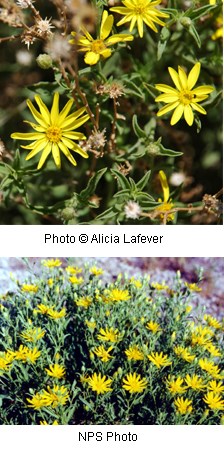
Chrysopsis villosa Synonym: Heterotheca villosa var. hispida Family: Asteraceae (A Utah Flora – Compositae) – Sunflower Family Perennial herbs; stems 5.9” to 1.6' (1.5 to 5 dm) tall Leaves: alternate; simple; has hairs; 0.2” to 2” (0.5 to 5 cm) long, 0.08” to 0.4” (2 to 10 mm) wide Flowers: yellow ray flowers and yellow disk flowers; flower head appears to be a single flower, but is composed of several flowers (a composite). 10-25 yellow rays are 0.24” to 0.4” (6 to 10 mm) long Pollinators: other genera in this family are pollinated by insects Fruits: achene – 1 seeded with hard shell Blooms in Arches National Park: March, April, May, June, July, August, September, October, November Habitat in Arches National Park: desert shrub, grassland and pinyon-juniper communities Location seen: park road mile 0 to 2.5, Fiery Furnace Other: The genus name, “Chrysopsis”, is from "chrysos" which means "golden," and “opsis” which means “bearing a resemblance or appearance” referring to the golden color of the flower heads. The genus name, “Heterotheca”, is from the Greek “hetero” meaning “different” and “theke” meaning “ovary”, referring to the unlike achenes of the ray and disk florets. The species name, “villosa”, means “soft-hairy” and refers to the gray hairs on the leaves and stems. The variety name, “hispida”, means “rough, with bristly hairs”. This family is the most advanced and complex of the dicots. The family is rich in oils and resins and is found in every part of the world, but is infrequent in the tropical rainforest. Aquatic or semi-aquatic species are also uncommon. |
Last updated: April 29, 2025
